





Humans have always been curious to unearth the mysteries of nature since the beginning of existence. It is a natural tendency of humans to utilize all gifts of nature to their optimum benefits. Gemstones are formed deep within Earth and mountains after a long natural process. After studying their effects over time, humans have used these gemstones for medicinal purposes, cosmetics and to alleviate the effects of afflicted planets. The Vedas, Puranas and other Hindu scriptures give detailed descriptions of 'Gemstones'. In India, hundreds of books are written on gemstones. Texts like Ratna Samuchchaya and Bhava Prakasha elucidate the applications of gemstones in detail. In Ayurvedic literature, the medicinal applications of gems are described. In astrological texts such as Brihat Samhita, gemstones are associated with planets and their origins and functions in countering the effect of afflicted planets are explained in detail.
According to the famous Ayurvedic book Sharangdhar Samhita, every substance has five different properties, namely six Rasa, five Guna, two Virya, three Vipaka and Prabhava. Prabhava is distinctive effectiveness of any substance which depends on its properties. Prabhava changes with a slight alternation in any of the properties of the substance. And this change can only be identified by extensive research. Vedic astrology and Ayurveda discuss the Prabhava of gemstones in great depth. The effect of gemstones and planets on the human body is described in great detail in various scriptures. According to astrological texts, Ruby (Manikya) is associated with Surya, Pearl (Moti) with Chandra, Red Coral (Munga) with Mangala, Emerald (Panna) with Budha, Yellow Sapphire (Pukhraj) with Brihaspati, Blue Sapphire (Neelama) with Shani, Diamond with Shukra, Hessonite (Gomeda) with Rahu and Cat's Eye (Lahasuniya) with Ketu. 84 substitute gemstones to these 9 gemstones are also popular. But these 9 gemstones are considered primary gemstones which are used by astrologers to alleviate the effects of afflicted planets.
1. 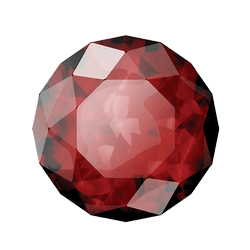 Ruby Gemstone
In Sanskrit literature, ruby is known by various names such as Manikya, Raviratna, Padmaraga and Kuruvinda. In Persian language, it is called 'Yakuta'. Ruby is categorized as the second hardest gemstone after diamond. The vibrant color of Ruby has attracted Kings and nobility for centuries. Rubies are mined from rocks consisting of granite, manganese and quartz. Myanmar, a country bordering northeastern states of India is famous worldwide for its brilliant red rubies. Additionally, ruby is also found in Sri Lanka, Africa, Afghanistan and Karur-Kangayam region of Southern India. According to a text called Ayurveda Prakasha, a ruby which is lustrous like petals of red lotus flower, is transparent, smooth, big and symmetrical, is considered of highest quality. In the present time, most rubies that are sold in the market are synthetic.
Ruby Gemstone
In Sanskrit literature, ruby is known by various names such as Manikya, Raviratna, Padmaraga and Kuruvinda. In Persian language, it is called 'Yakuta'. Ruby is categorized as the second hardest gemstone after diamond. The vibrant color of Ruby has attracted Kings and nobility for centuries. Rubies are mined from rocks consisting of granite, manganese and quartz. Myanmar, a country bordering northeastern states of India is famous worldwide for its brilliant red rubies. Additionally, ruby is also found in Sri Lanka, Africa, Afghanistan and Karur-Kangayam region of Southern India. According to a text called Ayurveda Prakasha, a ruby which is lustrous like petals of red lotus flower, is transparent, smooth, big and symmetrical, is considered of highest quality. In the present time, most rubies that are sold in the market are synthetic.

Astrological application of Ruby
In Vedic astrology, Surya is considered the ruling planet of the gemstone ruby. If the Surya is placed favorably in birth chart but lacks strength due to low dignity and doesn't give positive results, wearing ruby can be very beneficial for the native. Surya rules the sign of Simha in astrology. Therefore, people who have Simha as their ascendant or Moon sign can also wear ruby. Additionally, ruby is used in Ayurveda to treat diseases like tuberculosis, paralysis, hernia and blood circulation related issues. As per beliefs, ruby can also forewarn of any impending danger. But the gemstone should be used with care. Gemstones are like medicine and only a learned scholar should decide their application.
Method of Wearing and Usage
The ruby gemstone should be set in gold, copper or Panchadhatu (five-metal alloy). Because ruby is governed by Surya, it would be most favorable to wear it on Sunday and during the Surya-ruled Nakshatras like Krittika, Uttara Phalguni and Uttara Ashadha. According to Samudrika Shastra, the Surya rules the ring finger, therefore it is best to wear ruby on this finger. However, a purification process is essential before wearing it. Rubies under 3 Ratti (1 carat = 1.09 Ratti) should not be worn. Soak the ruby in raw milk of cow or Gangajal for some time. After meditating on Lord Shiva and seeking His permission, one should chant the following Surya Mantra 108 times to energize the ruby and then wear it.
ॐ घृणि सूर्याय नमः।
Om Ghrini Suryaya Namah
To find out if Ruby is your gemstone, please visit the Gemstone Calculator.
2. 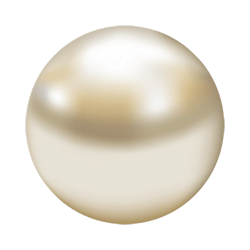 Pearl Gemstone
Pearl is an important gemstone among the Navaratna (Nine Gems). In literature, pearl has been used as a metaphor for good company for thousands of years. When a raindrop falls on a shelled mollusk during Swati Nakshatra, it transforms into a pearl but if it falls in the mouth of a snake, it turns into Halahala. Pearl is considered an auspicious gemstone. In Vedic astrology, pearl is associated with the Chandra. The pearl described in Vedic literature is a rare gemstone found in only a few of the thousands oysters that lie on the ocean floor. In this era of capitalism, pearls are artificially cultivated. But there are vast differences between natural pearls and cultivated pearls in terms of their optical quality, shape and medicinal properties. Generally, people can't differentiate between a natural pearl and a cultivated pearl from a pearl oyster. Cultivated pearl is not a natural pearl. The Ayurveda Prakasha text has described the qualities of a natural pearl in terms of its perfect spherical shape, smoothness, Moon-like lustre, its large size and light weight. These are the qualities of a superior pearl, which give it a superior status among gemstones. According to Brihat-Samhita, the pearl found in Persian Gulf is of the most superior quality. Additionally, pearls from Sri Lanka, Venezuela, Australia and Pacific Ocean are also considered of high quality.
Pearl Gemstone
Pearl is an important gemstone among the Navaratna (Nine Gems). In literature, pearl has been used as a metaphor for good company for thousands of years. When a raindrop falls on a shelled mollusk during Swati Nakshatra, it transforms into a pearl but if it falls in the mouth of a snake, it turns into Halahala. Pearl is considered an auspicious gemstone. In Vedic astrology, pearl is associated with the Chandra. The pearl described in Vedic literature is a rare gemstone found in only a few of the thousands oysters that lie on the ocean floor. In this era of capitalism, pearls are artificially cultivated. But there are vast differences between natural pearls and cultivated pearls in terms of their optical quality, shape and medicinal properties. Generally, people can't differentiate between a natural pearl and a cultivated pearl from a pearl oyster. Cultivated pearl is not a natural pearl. The Ayurveda Prakasha text has described the qualities of a natural pearl in terms of its perfect spherical shape, smoothness, Moon-like lustre, its large size and light weight. These are the qualities of a superior pearl, which give it a superior status among gemstones. According to Brihat-Samhita, the pearl found in Persian Gulf is of the most superior quality. Additionally, pearls from Sri Lanka, Venezuela, Australia and Pacific Ocean are also considered of high quality.

Astrological application of Pearl
In astrological texts, the pearl is described as an exceptionally powerful gemstone. If a person is experiencing challenges due to an afflicted or weak Chandra in their chart, it is advisable for them to wear a pearl. Additionally, if a person is Karka ascendant or has Karka Chandra in their chart, then wearing pearl may be beneficial for them under the guidance of a qualified astrologer. According to Ayurvedic texts, pearl can be beneficial for heart ailments. Additionally, pearl is also useful to treat conditions like diabetes, urinary tract infection, fever and in strengthening digestive system. Pearl can also be used in powdered form in Ayurveda. Pearl is considered particularly beneficial for women.
Method of Wearing and Usage
A pearl weighing 2, 4, 6 and 11 Ratti is considered ideal to wear. One should avoid wearing a pearl of 7 and 8 Ratti. A pearl can be worn on the little finger of the right hand on Monday of the Shukla Paksha of any month. A pearl should be purified by rinsing it with Panchamrita made with cow milk and Gangajal. Then it should be energized by chanting the following Chandra Mantra. Pearl should be set in silver metal.
ॐ सों सोमाय नमः।
Om Som Somaya Namah।
To find out if Pearl is your gemstone, please visit the Gemstone Calculator.
3. 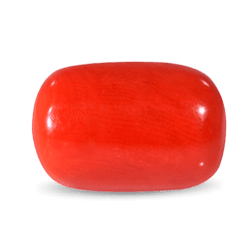 Red Coral Gemstone
Like pearls, red coral is not a mineral gemstone but is formed organically by the marine organism called Isis Nobilis. These organisms create coral in tree-like structures without leaves or branches, a form of marine invertebrate, that's why corals are referred to as Latamani in some ancient texts. Additionally, this gemstone is also called Pravala, Vidruma and Munga. Generally, corals grow up to 1 feet tall and 1 inch wide. Corals are naturally red and look very beautiful after polishing. Thus, they have been used in jewellery for many centuries. Red corals are easily found on seabed, but high quality corals are found in Persian Gulf, Algeria and Indian Ocean. According to Ayurvedic texts, a high quality red coral comes from a coral vine which glows with reddish brilliance of rising Sun, originates from ocean and doesn't lose its lustre upon polishing.
Red Coral Gemstone
Like pearls, red coral is not a mineral gemstone but is formed organically by the marine organism called Isis Nobilis. These organisms create coral in tree-like structures without leaves or branches, a form of marine invertebrate, that's why corals are referred to as Latamani in some ancient texts. Additionally, this gemstone is also called Pravala, Vidruma and Munga. Generally, corals grow up to 1 feet tall and 1 inch wide. Corals are naturally red and look very beautiful after polishing. Thus, they have been used in jewellery for many centuries. Red corals are easily found on seabed, but high quality corals are found in Persian Gulf, Algeria and Indian Ocean. According to Ayurvedic texts, a high quality red coral comes from a coral vine which glows with reddish brilliance of rising Sun, originates from ocean and doesn't lose its lustre upon polishing.

Astrological application of Red Coral
In Vedic astrology, red coral is associated with Mangala, who is regarded as the son of Bhudevi. If Mangala i.e. Mars is malefic in someone's birth chart, wearing a red coral is suggested by astrologers. Red coral has been proved highly effective in mitigating Mangal Dosha, as corroborated by Vedic scholars. Additionally, one can also donate coral depending on the placement of Mangala in their chart. If there is a conjunction of Chandra and Mangala in chart, then red coral can be worn in silver. Red coral can also be a good option for Mesha and Vrishchika ascendants and Moon sign. Furthermore, wearing red coral can benefit people suffering from neurological disorders, chronic constipation, diabetes, itching and other skin problems. Red coral is also used to prepare many medicines. However, one should not wear red coral without the guidance of a qualified astrologer.
Method of Wearing and Usage
People who are experiencing difficulties due to an afflicted Mangala and wish to wear coral gemstone may consider wearing the one that weighs 9, 11 or 12 Ratti. One should avoid wearing a 5 or 14 Ratti coral. Coral is set in gold, copper or Panchadhatu. It can be either worn on index finger or ring finger, as recommended by the astrologer. A coral can be worn on any Shukla Paksha Tuesday after worshipping Lord Hanuman, purifying it with Gangajal and energizing it by chanting the following Mantra 108 times.
ॐ अं अंगरकाय नमः।
Om Am Angarakaya Namah।
To find out if Red Coral is your gemstone, please visit the Gemstone Calculator.
4. 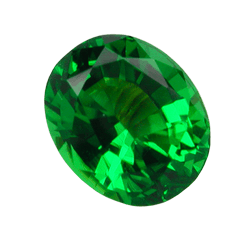 Emerald Gemstone
In ancient literature, emerald has been highly praised. Emerald adorned the palaces of Kings and wealthy merchants in various artistic creations. It is a beautiful gemstone of green color with bluish and greenish hues. According to scientific research, it appears green due to the presence of chromium oxide. At present, the mines in Columbia are famous worldwide for their superior quality emeralds. There are many emerald mines in Brazil and Russia's Ural Mountains as well. In ancient times, emeralds were primarily sourced from Egyptian mines. Ceyloni emeralds found in Sri Lanka and in the African nation of Zambia, are also renowned for their fine quality. In India, emeralds are mined in Rajasthan's Udaipur and Ajmer. According to the text Ayurveda Prakasha, a pure emerald should be heavy, lustrous, resilient, free from any deformity and clean and limpid as water. But an emerald with such qualities is rare to find. An emerald without any flaw may be more valuable than ruby and even diamond. Real emeralds are brittle and must be handled with care.
Emerald Gemstone
In ancient literature, emerald has been highly praised. Emerald adorned the palaces of Kings and wealthy merchants in various artistic creations. It is a beautiful gemstone of green color with bluish and greenish hues. According to scientific research, it appears green due to the presence of chromium oxide. At present, the mines in Columbia are famous worldwide for their superior quality emeralds. There are many emerald mines in Brazil and Russia's Ural Mountains as well. In ancient times, emeralds were primarily sourced from Egyptian mines. Ceyloni emeralds found in Sri Lanka and in the African nation of Zambia, are also renowned for their fine quality. In India, emeralds are mined in Rajasthan's Udaipur and Ajmer. According to the text Ayurveda Prakasha, a pure emerald should be heavy, lustrous, resilient, free from any deformity and clean and limpid as water. But an emerald with such qualities is rare to find. An emerald without any flaw may be more valuable than ruby and even diamond. Real emeralds are brittle and must be handled with care.

Astrological application of Emerald
In Vedic astrology, emerald gemstone is considered to be governed by the planet Budha. If Budha is functional benefic in birth chart but lacks strength, then wearing emerald can increase the positive influence of Budha. Emerald is an extensively used gemstone because of its beauty. Those who have Mithuna and Kanya signs as their ascendant are particularly advised to wear emerald. Budha is associated with intellect and business acumen. Therefore, many people wear emerald for success in their business and career. In Ayurvedic texts, emerald is considered beneficial against poisoning, injuries and piles.
Method of Wearing and Usage
The gemstone emerald can be set in gold, silver and Panchadhatu. It is recommended to wear an emerald on any Shukla Paksha Wednesday within 48 minutes after sunrise. It can be worn on either the middle finger or the little finger. Before wearing an emerald, purify it with raw cow's milk and Gangajal. Then worship Lord Vishnu and energize the gemstone by chanting the following Mantra 108 times.
ॐ बुं बुधाय नमः।
Om Bum Budhaya Namah।
To find out if Emerald is your gemstone, please visit the Gemstone Calculator.
5. 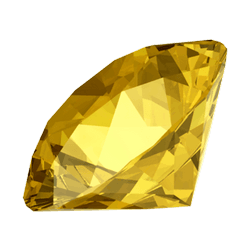 Yellow Sapphire Gemstone
Yellow Sapphire or Topaz is a highly regarded gemstone among Navaratna. This gemstone with its yellow hue is called Pita Sphatika and Pushpa Raga in Sanskrit. It's common name in India is Pukhraj. The chemical composition of topaz includes aluminium sulfate fluoro oxide. This gemstone is formed as a result of the reaction of the vapours of igneous rocks such as granite and pegmatite with fluorine gas. The finest quality topaz are sourced from the mines of Brazil. Sri Lankan topaz is highly valued as well. Topaz found in the areas where ruby mines are nearby are considered to be of excellent quality. According to the ancient texts, a good quality topaz is heavy, shines with a yellow hue like the flowers of Amaltas, smooth, spotless and transparent.
Yellow Sapphire Gemstone
Yellow Sapphire or Topaz is a highly regarded gemstone among Navaratna. This gemstone with its yellow hue is called Pita Sphatika and Pushpa Raga in Sanskrit. It's common name in India is Pukhraj. The chemical composition of topaz includes aluminium sulfate fluoro oxide. This gemstone is formed as a result of the reaction of the vapours of igneous rocks such as granite and pegmatite with fluorine gas. The finest quality topaz are sourced from the mines of Brazil. Sri Lankan topaz is highly valued as well. Topaz found in the areas where ruby mines are nearby are considered to be of excellent quality. According to the ancient texts, a good quality topaz is heavy, shines with a yellow hue like the flowers of Amaltas, smooth, spotless and transparent.

Astrological application of Yellow Sapphire
The gemstone topaz is considered to be governed by Brihaspati i.e. Guru. It is advised to wear topaz to strengthen weak Brihaspati in birth chart. Topaz is believed to enhance prosperity, generosity, material happiness and longevity. It also sharpens intellect, removes unknown fear and protects against sudden death. But astrology has some rules for wearing topaz. Brihaspati rules the Meena and Dhanu signs in astrology. Thus, those with their ascendant and Chandra in these signs can wear topaz to strengthen Brihaspati in their chart. When a girl experiences challenges in getting married despite significant efforts, then astrologers recommend to wear topaz gemstone to enhance Brihaspati's influence as the significator of marriage. According to ancient beliefs, rubbing topaz on a poisonous bite can neutralize the poison. Topaz is also beneficial in the treatment of ailments like goiter, diarrhoea, thyroid issues, jaundice, encephalitis, among others.
Method of Wearing and Usage
The gemstone topaz should be set in gold or Panchdhatu. Avoid using topaz that weighs 6, 11, or 15 Ratti. It can be worn on any Shukla Paksha Thursday. To wear the gemstone, first wake up before sunrise and worship Lord Shiva and Lord Vishnu. Then purify the gemstone using raw cow's milk, pure Ghee and Gangajal. After this, chant the following Mantra 108 times to energize the gemstone and then wear it on the index finger.
ॐ बृं बृहस्पतये नमः।
Om Brim Brihaspataye Namah।
To find out if Yellow Sapphire is your gemstone, please visit the Gemstone Calculator.
6. 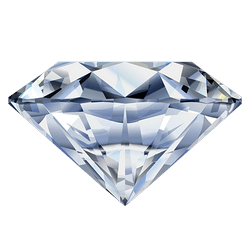 Diamond Gemstone
Diamond is an extremely rare and precious gemstone and calling it Ratna Shiromani (the crest-jewel) would not be an exaggeration. The diamond is used as a metaphor to describe finest quality in any category. Diamond is not only a beautiful gemstone but also the hardest naturally occurring substance on Earth. It can't be scratched by any other material. Due to its high refractive index, when moved, the facets of diamond sparkle in rainbow colors which experts call fire. Diamonds shine the brightest because of total internal reflection, which makes them highly valuable. In ancient India, diamonds were mined from river Ponnaiyar of Tamil Nadu, river Sone of Bundelkhand, Khan river and other river deposits. India's Kohinoor diamond is famous worldwide for its beauty. The Garuda Purana provides extensive information about diamonds, classifying them as male, female and neutral according to their color and nature. Additionally, diamonds are also classified in Varna, namely Brahmin, Kshatriya, Vaishya and Shudra.
Diamond Gemstone
Diamond is an extremely rare and precious gemstone and calling it Ratna Shiromani (the crest-jewel) would not be an exaggeration. The diamond is used as a metaphor to describe finest quality in any category. Diamond is not only a beautiful gemstone but also the hardest naturally occurring substance on Earth. It can't be scratched by any other material. Due to its high refractive index, when moved, the facets of diamond sparkle in rainbow colors which experts call fire. Diamonds shine the brightest because of total internal reflection, which makes them highly valuable. In ancient India, diamonds were mined from river Ponnaiyar of Tamil Nadu, river Sone of Bundelkhand, Khan river and other river deposits. India's Kohinoor diamond is famous worldwide for its beauty. The Garuda Purana provides extensive information about diamonds, classifying them as male, female and neutral according to their color and nature. Additionally, diamonds are also classified in Varna, namely Brahmin, Kshatriya, Vaishya and Shudra.

Astrological application of Diamond
In Hindu scriptures and Vedic astrology, the diamond is considered an important gemstone. According to the Garuda Purana, diamond has the ability to enhance wealth, prosperity and progeny. The diamond is also beneficial for increasing material comforts and luxuries in life. In ancient times, wealthy people used to wear diamonds to make their lives more luxurious. The diamond is associated with planet Shukra. In astrology, Shukra is considered the significator of sensual pleasures. Therefore, the diamond is worn to enhance the power of Shukra. Vrishabha and Tula ascendants can wear diamond without any concern. According to the Ayurvedic texts Bhava Prakasha, the diamond powder can increase physical strength. In Ayurveda, some of the most serious health issues can be treated with diamond powder. Wearing diamond can also benefit in curing heart ailments, tuberculosis, anaemia and impotency. However, one should only wear diamond under the guidance of a qualified astrologer.
Method of Wearing and Usage
The diamond is set in gold or silver. It can be worn on any Shukla Paksha Friday after sunrise during the day Hora of Shukra, on the ring finger. In certain situations, the diamond can be worn on the middle finger. Before wearing it, one should worship Lord Lakshmi Narayana, then rinse it with Panchamrita, rose water and Gangajal. Thereafter, energize the diamond by chanting the following Mantra and wear it.
ॐ शुं शुक्राय नमः।
Om Shum Shukraya Namah।
To find out if Diamond is your gemstone, please visit the Gemstone Calculator.
7.  Blue Sapphire Gemstone
This gemstone with a bluish hue is famous for giving quick results. People are generally intimidated by this gemstone despite finding it very beautiful. Like ruby, blue sapphire also belongs to corundum family. In Sanskrit, it is called Indranila, Nilamani and Shauriratna. The blue sapphire found in the Kashmir valley of India is considered to be the most beautiful and of highest quality and thus highly valuable. It resembles the blue color of peacock's neck. The blue sapphire found in Myanmar, Sri Lanka and the Salem district of Southern India is also considered of high quality. According to ancient texts, blue sapphire are classified in two categories, namely Indranila and Jalanila. Indranila has darker tint with outer bluish hue, while the Jalanila has whitish tint with outer bluish hue. One special quality of blue sapphire is that it doesn't get overshadowed by other substances and illuminates them with its own radiance.
Blue Sapphire Gemstone
This gemstone with a bluish hue is famous for giving quick results. People are generally intimidated by this gemstone despite finding it very beautiful. Like ruby, blue sapphire also belongs to corundum family. In Sanskrit, it is called Indranila, Nilamani and Shauriratna. The blue sapphire found in the Kashmir valley of India is considered to be the most beautiful and of highest quality and thus highly valuable. It resembles the blue color of peacock's neck. The blue sapphire found in Myanmar, Sri Lanka and the Salem district of Southern India is also considered of high quality. According to ancient texts, blue sapphire are classified in two categories, namely Indranila and Jalanila. Indranila has darker tint with outer bluish hue, while the Jalanila has whitish tint with outer bluish hue. One special quality of blue sapphire is that it doesn't get overshadowed by other substances and illuminates them with its own radiance.

Astrological application of Blue Sapphire
In Vedic astrology, the blue sapphire is considered an important gemstone. This gemstone is ruled by Shani, the lord of Karma and the son of Surya. Blue Sapphire is known to give quick results. The Lamas of Tibet consider blue sapphire a powerful gemstone for calming the subconscious mind. Indian astrologers, however, advice caution with this gemstone. As per the beliefs, a favorable blue sapphire can make a person successful overnight and an unfavorable one can have adverse effects. Therefore, blue sapphire should never be worn without the guidance of a qualified astrologer. Shani rules Makara and Kumbha signs. If Shani is weak in birth chart but placed favorably, then wearing a blue sapphire can strengthen a weak Shani. This gemstone is particularly beneficial during the Mahadasha and Sade Sati of Shani. Blue Sapphire is proved to be beneficial to cure rheumatic disease like arthritis, neurological disorder like sciatica, bladder infection and kidney-related ailments.
Method of Wearing and Usage
The blue sapphire can be set in silver, gold and Panchadhatu. To pacify the effects of a malefic Shani in birth chart, one should wear blue sapphire on any Shukla Paksha Saturday or on Shani Trayodashi. After worshipping Lord Shiva with proper rituals and seeking His permission, rinse the gemstone with cow's milk and Gangajal and energize it by chanting the following Mantra for 108 times. Thereafter, it should be worn on the middle finger.
ॐ शं शनैश्चराय नमः।
Om Sham Shanaishcharaya Namah।
To find out if Blue Sapphire is your gemstone, please visit the Gemstone Calculator.
8. 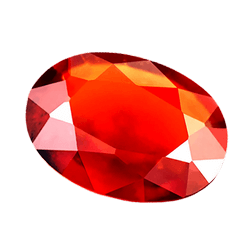 Hessonite Gemstone
Hessonite is considered to be an important gemstone among the Navaratna. It is a beautiful stone and found easily in various colors. Yellow and deep red hessonite, similar to the color of cow urine, is considered the most attractive form of hessonite. After diamond, hessonite has the highest light dispersion which gives it a brilliance second only to diamond. Hessonite is found in smooth, round stones in sedimentary deposits. Hessonite is abundantly found in Australia, Thailand and Sri Lanka. The hessonite found in Sri Lanka is particularly beautiful and for a long time locals mistook the colorless varieties for diamond. Hessonite is used in various types of jewellery. According to ancient Ayurvedic and astrological texts, to identify real hessonite, one should check its clear, cow urine-like lustre, smoothness and weight.
Hessonite Gemstone
Hessonite is considered to be an important gemstone among the Navaratna. It is a beautiful stone and found easily in various colors. Yellow and deep red hessonite, similar to the color of cow urine, is considered the most attractive form of hessonite. After diamond, hessonite has the highest light dispersion which gives it a brilliance second only to diamond. Hessonite is found in smooth, round stones in sedimentary deposits. Hessonite is abundantly found in Australia, Thailand and Sri Lanka. The hessonite found in Sri Lanka is particularly beautiful and for a long time locals mistook the colorless varieties for diamond. Hessonite is used in various types of jewellery. According to ancient Ayurvedic and astrological texts, to identify real hessonite, one should check its clear, cow urine-like lustre, smoothness and weight.

Astrological application of Hessonite
According to Vedic astrology texts, Rahu governs the gemstone hessonite. Rahu is associated with illusion and delusion. When Rahu has a highly negative influence in birth chart, donating hessonite gemstone is recommended. If Rahu is placed favorably in the chart, hessonite can be worn to enhance its positive influence. This can counter the negative influence of Rahu. An unfavorably placed Rahu can lead to severe issues like skin disease, insomnia, possession and leprosy. In such cases, using the hessonite carefully can help control these ailments.
Method of Wearing and Usage
The hessonite gemstone can be set in silver, or if possible, in Ashtadhatu (8-metal alloy). Ideally, it should weigh 6, 11 and 13 Ratti. The hessonite weighing 7, 10 and 16 Ratti should be avoided. It can be worn on Wednesday or Saturday of any month, after worshipping Lord Shiva and Goddess Durga in the morning, rinsing it with Gangajal and energizing it by chanting the following Mantra. Wear the gemstone on the middle finger of your right hand.
ॐ रां राहवे नमः।
Om Ram Rahave Namah।
9. 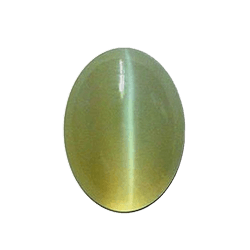 Cat's Eye Gemstone
In ancient Sanskrit literature, the gemstone Cat's Eye is referred to as Vaidurya Mani, Lahasuniya and Vidalaksha. It is called Vidalaksha because of its color which resembles the eyes of a cat shining in the dark. This gemstone has a yellow hue with white thread-like stripes. When rotated, the position of its optic axis shifts. Its primary chemical composition is beryllium aluminium oxide. In India, it is found abundantly in Thiruvananthapuram. It is also found widely in Sri Lanka, China and Brazil. A transparent and lustrous Cat's Eye with black and white shine is considered to be of high quality.
Cat's Eye Gemstone
In ancient Sanskrit literature, the gemstone Cat's Eye is referred to as Vaidurya Mani, Lahasuniya and Vidalaksha. It is called Vidalaksha because of its color which resembles the eyes of a cat shining in the dark. This gemstone has a yellow hue with white thread-like stripes. When rotated, the position of its optic axis shifts. Its primary chemical composition is beryllium aluminium oxide. In India, it is found abundantly in Thiruvananthapuram. It is also found widely in Sri Lanka, China and Brazil. A transparent and lustrous Cat's Eye with black and white shine is considered to be of high quality.

Astrological application of Cat's Eye
In Vedic astrology, Ketu governs the gemstone Cat's Eye, which is also known as Vaidurya Mani i.e. Lahasuniya. This gemstone plays a significant role in pacifying the malefic effects of Ketu. Symptoms of an afflicted Ketu involve short temper, acute stress, depression, secretive behavior and a tendency towards solitude. In such cases, one should donate or wear a Cat's Eye gemstone according to the placement of Ketu in birth chart. The Cat's Eye also protects the wearer from sudden mishaps and conspiracies. According to Ayurveda, Cat's Eye is also known to relieve ailments caused by aggravated bile.
Method of Wearing and Usage
The Cat's Eye gemstone can be set in gold or silver and worn on Saturday or Tuesday of any month. Ideally, it should weigh 3, 5 or 7 Ratti. While stones weighing 2, 4, 11 and 13 Ratti should be avoided. Before wearing it, first worship Lord Ganesh with proper rituals, then purify it with Panchamrita and rinse it with Gangajal. Afterward, energize it by chanting the following Mantra and wear it.
ॐ कें केतवे नमः।
Om Kem Ketave Namah।